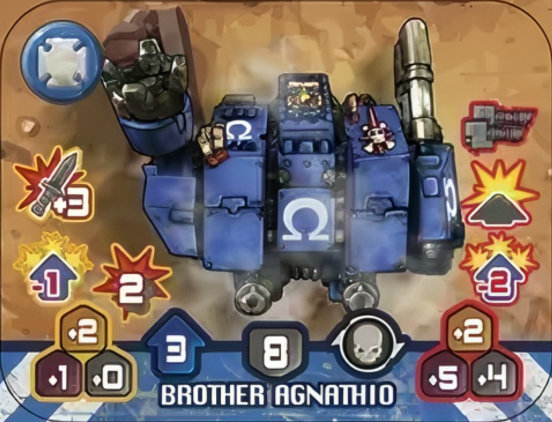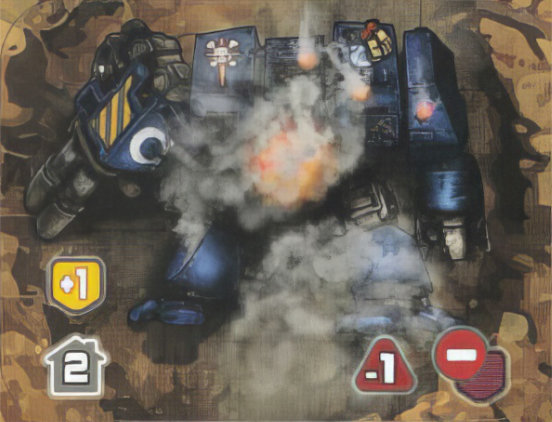Brother Agnathio
Primary Weapon 1 Abilities
During a Firing Action, roll two dice and keep the best result.
This Unit has weapons that are exceptionally good at penetrating enemy armour. Add 1 to the die roll when rolling for the Damage location on a Heavy Vehicle Hit by this attack. Also, any Unit Hit by this attack cannot attempt an Armour Save .
This Unit may take a Firing Action during its Movement Action. The Fire on the Move attack can be executed once during each Movement Action the Unit takes, either before the Unit leaves a square or immediately after entering a square.
Attacks made with Fire on the Move are less accurate than normal attacks, so the Unit suffers the penalty (if any) indicated in the Fire on the Move symbol (subtract it from the Unit's Combat Value).
Secondary Weapon Abilities
Only Units that have the Assault Special Ability may engage an enemy Infantry Unit or Vehicle in close combat.
In most cases, a Vehicle will not have this ability. Units that do not have the Assault Special Ability can still defend themselves in close combat, but they only roll 1 die. If a Unit has an X for a Combat Value, it means that it cannot Assault a target of that type (unless you have another Special Ability or Gear that allows it).
This Unit may take a Firing Action during its Movement Action. The Fire on the Move attack can be executed once during each Movement Action the Unit takes, either before the Unit leaves a square or immediately after entering a square.
Attacks made with Fire on the Move are less accurate than normal attacks, so the Unit suffers the penalty (if any) indicated in the Fire on the Move symbol (subtract it from the Unit's Combat Value).
If this Unit is adjacent to a Structure at the end of its Movement Action and it did not make an Assault, it can try to damage the Structure. Roll the number of dice indicated on the Special Ability symbol. Each result of 4 or higher adds 1 Destruction Point to the Structure (see Destruction p.15).

Terrain Effects
Any Unit in this Terrain Element receives the bonus if the colour of the Unit's Defence Value type is the same as the colour of the Terrain Element's symbol.
Add the bonus printed in the symbol to the Unit's Defence Value.
Some Terrain Elements, such as Buildings or wrecked Vehicles, are called Structures.
Unlike other Terrain Elements, Structures can be Destroyed.
In order to destroy them, you need to deal as many Destruction Points as are printed on the symbol (see Destruction, p.15). Once this number has been reached, turn the Terrain Element over to its rubble side, or, if it is a Wreck, remove it from the game.
Every square marked with this symbol obscures LoS that passes through it (even partially). For every square that obscures LoS, subtract the value printed in the symbol from the attacker's final die roll result (instead of directly from the Unit's Combat Value). These penalties are cumulative.
Do not count the squares occupied by the firing Unit or the target Unit.
WARNING: Do not count the square that the firing Unit is in or the square occupied by the target when checking for LoS and obscuring terrain!
When an Obstacle between two squares obscures Los (but does not block it) -such as a wall-any Unit directly adjacent to the Terrain Element ignores its effects, even if using a Flamer Template. Al other Units are affected normally.
If a Template (not a Flamethrower template) is placed on a Terrain Element that is between two squares, the penalty is applied to Units and Structures located on both sides of the Terrain Element.
These Terrain Elements prevent certain Units from entering. The type of Unit is identified by the colour of the shield or shields that accompany the Impassable symbol. Any restricted Unit that somehow finds itself partially or fully entering a square Impassable to it is automatically Destroyed. If the Unit is a Vehicle, put its wreck as close as possible to the Impassable element without being in it.
